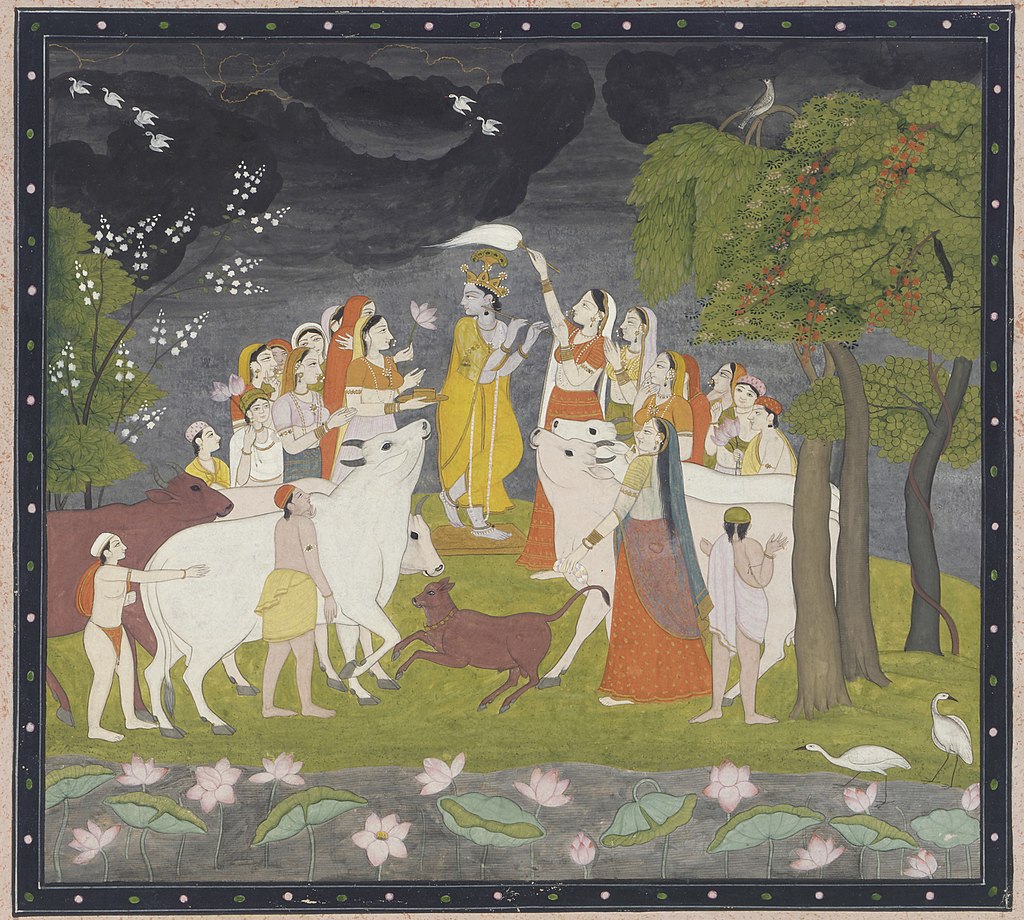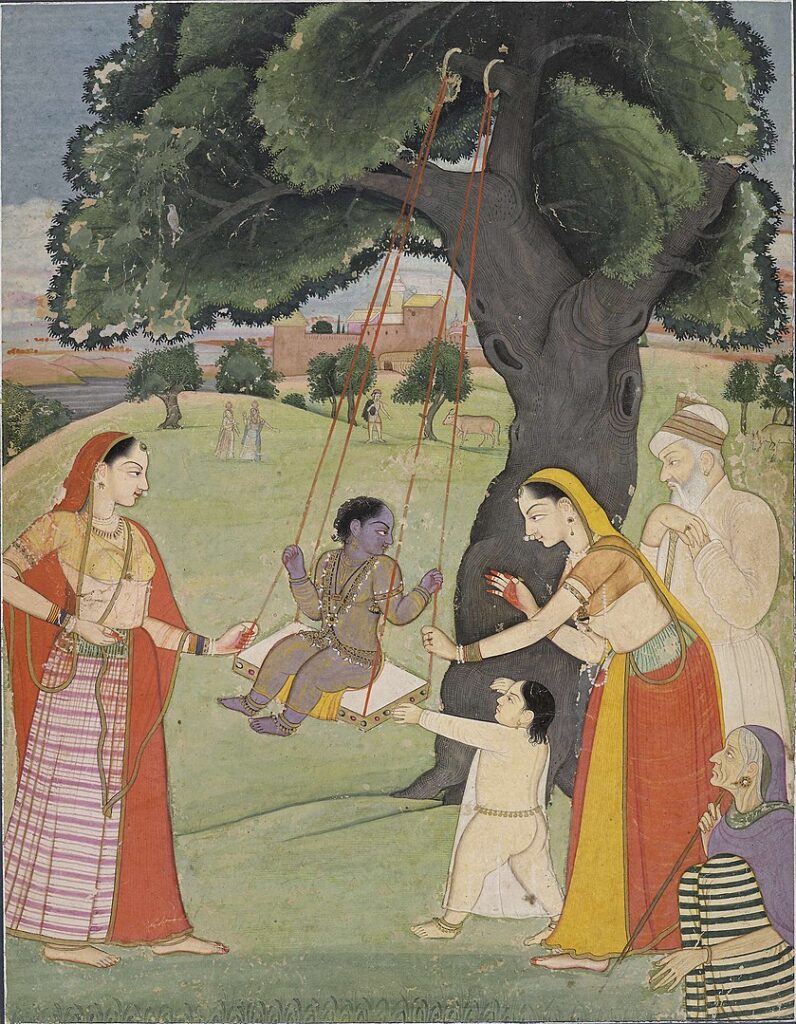A lecture on what is spirituality and the benefits of practicing spirituality. The video discusses our material predicament and the spiritual solution to escape from our material quagmire.
Category: Gaudiya Vaishnavism

Shanta rasa is the mellow of divine love (Rasa) that falls within the purview of Narayana pujan (worship of Lord Narayana). This is a neutral state in which the devotee neither feels any fondness for his worshipable Lord Narayana nor does he have any attachment towards the world. He offers the Lord his love in a manner sanctioned by the scriptures. The indifference of the servant towards his Lord is the chief characteristic of this stage. Shanta rasa is the neutral stage where there exists attachment for Krishna in the mood of awe and veneration; there is complete detachment from all material desires; nonetheless, in Shanta rasa, there is also a lack of intimacy between the devotee and the Supreme Lord.
The bliss that is experienced in Brahman realization (brahmananda) by the impersonalists, or the pleasure of realizing the self (atmananda), experienced by the yogis steeped in meditation upon the inner self, is nothing compared to the delight felt in realizing the Supreme Lord. The beautiful form of the Supreme Lord is the source of all spiritual bliss. Devotees like Bilvamangala Thakura, Sukadeva Goswami, and Sarvabhauma Bhattacharya had attained nirvishesa brahma (impersonal brahman) through their pursuits of Jnana (speculative knowledge) but had rejected brahmananda (bliss in impersonal brahman realization) in favor of bhakti-rasananda, the nectarean divine bliss of devotion.

Rasa, or divine mellows, is remarkable and the most esoteric truth. It is the culmination of the transcendental pastimes of Sri Krishna, the Supreme Personality of Godhead. When devotion unto Krishna reaches the peak of purity and grows dynamically active, it transforms into ‘Krishna Bhakti Rasa’, the mellows of devotion towards Krishna.
Unless a devotee attains pure devotion and reaches the stage of a ‘sadhaka’, he is not qualified to experience ‘rasa’. A ‘sadhaka’ is a devotee who has attained attraction for Krishna but might not be completely free from all anarthas (material impurities). A neophyte devotee, however, who engages in deity worship in the temple but behaves improperly with others, is not qualified to relish rasa (divine mellows).
‘Siddhas’ are those devotees whose activities revolve solely around Sri Krishna and who always crave to relish Krishna bhakti rasa. They have attained perfection in their devotional lives either through sadhana (devotional practice), Kripa (mercy of exalted souls or God), or else they are eternally perfected souls (Nitya Siddha).
Krishna is the root cause of divine love whereas Krishna’s personal traits and paraphernalia act as ‘uddipana’ or that which evokes ecstatic love for Him. ‘Uddipana’ helps stimulate the devotee’s latent love for Krishna, which in course of time manifests itself as ‘rasa’.

Yoga, contrary to popular opinion, does not refer to some impossible physical postures. The actual meaning of Yoga does not merely refer to bending, curving your body, or even holding your breath. The word yoga is derived from the Sanskrit root yuj, meaning “to yoke,” or “to unite”. The practice aims to create a union between body, mind, and spirit, as well as between the individual self and universal consciousness.
The yoga system was originally meant for realizing God, and all varieties of yoga practice are assumed to bring one to that point. Success in Yoga ultimately depends on the quality of one’s consciousness and the will of the Supreme Person, rather than on our own gymnastic endeavors. The various yogic asanas, breath control, and withdrawal of the senses are meant to help pacify the mind so that one can focus one’s entire attention on the Supreme Lord (Paramatma) who is eternally present within our heart. In this article, we shall present all the relevant information and scriptural evidence that one needs to know concerning Yoga.

Yoga, contrary to popular opinion, does not refer to some impossible physical postures. The actual meaning of Yoga does not merely refer to bending, curving your body, or even holding your breath. The word yoga is derived from the Sanskrit root yuj, meaning “to yoke,” or “to unite”. The practice aims to create a union between body, mind, and spirit, as well as between the individual self and universal consciousness. The yoga system was originally meant for realizing God, and all varieties of yoga practice are assumed to bring one to that point. Success in Yoga ultimately depends on the quality of one’s consciousness and the will of the Supreme Person, rather than on our own gymnastic endeavors. The various yogic asanas, breath control, and withdrawal of the senses are meant to help pacify the mind so that one can focus one’s entire attention on the Supreme Lord (Paramatma) who is eternally present within our heart.

The process of Yoga connects one to his/her spiritual essence. There are several kinds of Yoga, but it has been broadly classified into 3 – Karma Yoga, Jnana Yoga, and Bhakti Yoga. We have discussed Karma Yoga previously. In this article, we shall be discussing Jnana Yoga in detail. Jnana Yoga involves mental speculation, evaluating ideas, through logic and discourse, and aspiring to ultimately comprehend what is what. Jnana Yoga is the realization of the self through philosophical discussions. Jnana Yoga involves discrimination between matter and spirit through mental speculation. Hence Jnana Yoga promotes knowledge through seclusion, study, and sense abnegation. Activities and necessities of life are minimized in Jnana Yoga, as the focus is placed on becoming free from sensual desires that deceive the soul. By rejecting matter, Jnana Yogis aim at attaining liberation (moksha).

According to the ‘Sandilya Bhakti Sutra’, Bhakti is the transcendental attachment to Krishna, the Supreme Lord. The process of reawakening this transcendental loving relationship between God and the living entity is called ‘Bhakti Yoga’. Bhakti or pure devotional service is free from all traces of Karma (fruitive activities) and Jnana (speculative knowledge). A devotee established in Bhakti Yoga, constantly serves Krishna, engaging his mind, intellect and all of his senses in the Lord’s service. Bhakti Yoga purifies one and frees one from all material designations. Upon attaining pure love of God, one neither hankers nor laments. He is freed from all attachments and detachments, and takes no pleasure in material things. Lord Krishna explains the exalted stature of Bhakti Yoga in Bhagavad Gita as follows –
tapasvibhyo ‘dhiko yogi
jnanibhyo ‘pi mato ‘dhikah
karmibhyas cadhiko yogi
tasmad yogi bhavarjuna
(Bhagavad Gita 6.46)
–
A yogi is greater than the ascetic, greater than the wise speculative thinker and greater than the fruitive worker. Therefore, O Arjuna, under all circumstances, be a yogi.
yoginam api sarvesam
mad-gatenantar-atmana
sraddhavan bhajate yo mam
sa me yuktatamo matah
(Bhagavad Gita 6.47)
–
And of all yogis, he who always abides in Me (Krishna) with great faith, worshiping Me in transcendental loving service (bhakti), is most intimately united with Me in yoga and is the highest of all. That is My opinion.
Contents : Identity, Pastimes and Teachings of Sri Chaitanya Mahaprabhu
Identity – Who is Chaitanya Mahaprabhu ?
- Chaitanya Mahaprabhu is Lord Krishna | Evidence from Vedic scriptures
- Gauranga and Krishna – Lord Krishna reveals the form of Gauranga
- Chaitanya Mahaprabhu – Biography, Teachings & Hare Krishna movement
- Kali Yuga and its savior – Chaitanya Mahaprabhu | Chaitanya Upanishad
- Gauranga Mora Dharma
- Devotion to Lord Gauranga is the topmost spiritual practice
- 108 Names of Chaitanya Mahaprabhu | Gauranga Ashtottara ShataNamaVali
- Sri Godruma Chandra Bhajan upadesha – Worshiping Lord Chaitanya, the moon of Godruma
- Lord Chaitanya and the Parrot | Holy name of Gauranga | Prema Vivarta

Namo brahmanya devaya
Go brahmana hitaya ca
Jagad dhitaya Krsnaya
Govindaya namo namah
(Vishnu Purana 1.19.65)
–
I offer my obeisances again and again to Lord Krishna, who is always worshiped by qualified brahmanas and is very dear to them. He is always concerned with the welfare of the cows, the brahmanas, and the whole world. I offer my repeated obeisances unto the Personality of Godhead, known as Krishna and Govinda.
The above mantra, quoted in Vishnu Purana, is used to worship and offer bhoga to Lord Krishna. The above prayer lays a striking emphasis on the protection of cows and the brahmanas. Brahmanas, or the intellectuals, are the symbols of spiritual education. In Vedic India, cows were treated as mothers and they sustained the entire society with their milk. From the above verse, it is abundantly clear that cows were very dear to Krishna. In fact, the Bhagavad Gita quotes Lord Krishna in saying –

Actions that are performed in terms of one’s prescribed duties, as mentioned in the revealed scriptures, are called Karma. ‘Akarma’ are actions that are devoted to the Supreme Lord and are free from material bondage. Actions that are opposed to the instructions of the revealed scriptures, performed through the misuse of one’s freedom, are called ‘Vikarma’.
‘Vikarma’ leads one to the lower forms of life. Of these three, the work, i.e. Akarma, that frees one from the bondage of material life, is favored by intelligent men. Ordinary men might want to conduct good deeds for fame and recognition in this life or perhaps attain heavenly pleasures in the next. However, intelligent men know that both good and bad work binds one to material miseries and hence they choose to act so that they would become free from both good and bad reactions. Vikarma, however, is sinful work that drags one to hellish life.
